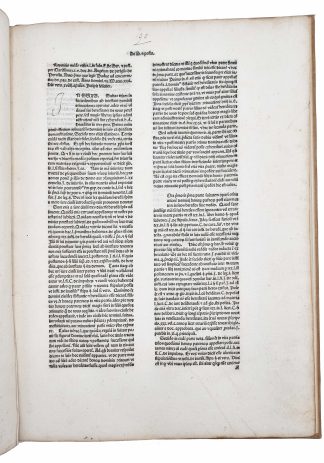CACCIALUPIS, Johannes Baptista de, et al [with] PERIGLIS, Angelus de.
SCARCE SIENA LEGAL INCUNABLE - ON GAMBLING
De ludo. [with] De liberis et posthumis.
I: [Siena, Henricus de Harlem, 10 Oct 1494]; II: Siena, Henricus de Harlem, 28 May 1494.£17,500.00
FIRST EDITION of II. Large folio, 385 x 275mm. 2 works in 1. I: ff. [12], a-b4 [*]4; II: ff. [20], A-E4. Gothic letter, double column. Marginal foxing and very light marginal water stain in places. Very good, large, wide-margined, crisp copies, on thick high-quality paper, in modern tan morocco, blind-stamped ‘Burlamacchi’ to lower cover. Occasional C16 ms annotations to margins, ms page numbers or headers in the same hand.
Imposing copies of these scarce Sienese incunable editions of important legal treatises on gambling and inheritance, with Justinian’s ‘Digest’ as their starting point. The Dutch printer Henricus de Harlem (fl.1482-95) worked in Venice, Bologna and Siena, renowned for his ‘grand legal folios’, like the present (Goldschmidt, p.20) – which were valued as practical texts for hundreds of years.
G.B. de Caccialupis (1420-96) was a jurist from Ancona who taught at the university for 20 years. Written in 1466, ‘De ludo’ was first published only in 1493, in Urbino, and subsequently in this second ed. in Siena. It belongs to a legal genre, which flourished at the time producing treatises titled ‘de ludo’ or ‘de luto et ioco’, devoted to gambling, but at times expanding the discussion to ‘games’ such as dancing and entertainment. ‘De ludo’ examines the definition of ‘ludus’, its kinds, who is allowed to watch them, gambling in particular (e.g., dice), law against ‘ludus’, punishments, its status as a crime, and what happens when the civil law goes against local laws which allow ‘ludus’. ‘Lecit games’ include chess; forbidden games include those which are ‘solely based on fortune’ (and risk-taking based on predictions). Among the issues surrounding illicit ‘ludus’ are the secondary social problems arising from it, such as blasphemy, drinking, harm and violence. Sections are concerned with circumstances in which ‘ludus’ takes place, including when people under 25 are involved, or the value of contracts or sales agreed during ‘ludus’; as well as with methods of restitution to its victims. Appended are a few short legal treatises. For instance, Angelo de Periglis’ ‘De sequestris’ concerns the seizing of people’s goods in case of litigation, followed by Bartholomeus de Saxoferrato’s on the seizure of private property. Martin de Fano’s on ‘Qualitas negativa’, i.e., negation or denial, such as when someone denies an accusation but, cannot prove that a fact or action did not happen, or when an object has a defect. Fano’s treatise on ‘Exceptiones impedientes’ examines issues which may prevent a lawsuit from starting, including an unsuitable judge or the death of a party.
The second work, here in its first edition, is a treatise on the determination of inheritance and circumstances for disinheritance. Angelus de Periglis (d.1492) was a jurist from Perugia of whom little is known.‘De liberis et posthumis’ is a compendium of all the laws concerning inheritance, which presents a variety of cases, beginning from who has the right to inherit, to what should be done if the children are not aware of the father’s death, when a child dies during his father’s lifetime, what should a father do to disinherit his children, and what to do in case of inheritance fights, e.g., when the last will is questioned. A very handsome, large, wide-margined legal incunable, and a scarce Sienese imprint.
Burlamacchi may be the historical Tuscan family of silk merchants from Lucca, among whom was the Gonfalonier Francesco Burlamacchi (d.1549).
I: Only Harvard copy recorded in the US. Not at BL. ISTC ic00005000; Goff C5; H 4204; BSB-Ink C-17, C-18; GW 5840. II: Harvard, Huntington, LC and Yale recorded in the US. Not at BL. ISTC ip00285000; Goff P285; H 12633*; BSB-Ink P-211; GW M31050. E.P. Goldschmidt, The First Cambridge Press in Its European Setting (2010); A. Arcangeli, ‘Danza e spettacolo nel diritto comune’, in La scena assente. Realtà e leggenda sul teatro nel Medioevo (2006), pp.175-92.

![CACCIALUPIS, Johannes Baptista de, et al [with] PERIGLIS, Angelus de.](https://sokol.co.uk/wp-content/uploads/2024/11/L4203-1-1.jpg)
![CACCIALUPIS, Johannes Baptista de, et al [with] PERIGLIS, Angelus de. - Image 2](https://sokol.co.uk/wp-content/uploads/2024/11/L4203-5.jpg)
![CACCIALUPIS, Johannes Baptista de, et al [with] PERIGLIS, Angelus de. - Image 3](https://sokol.co.uk/wp-content/uploads/2024/11/L4203-4-1.jpg)
![CACCIALUPIS, Johannes Baptista de, et al [with] PERIGLIS, Angelus de. - Image 4](https://sokol.co.uk/wp-content/uploads/2024/11/L4203-3-1.jpg)
![CACCIALUPIS, Johannes Baptista de, et al [with] PERIGLIS, Angelus de. - Image 5](https://sokol.co.uk/wp-content/uploads/2024/11/L4203-2-1.jpg)
![CACCIALUPIS, Johannes Baptista de, et al [with] PERIGLIS, Angelus de. - Image 7](https://sokol.co.uk/wp-content/uploads/2024/11/L4203-4.jpg)
